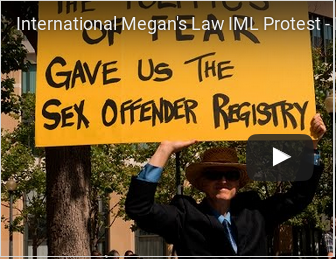
WAR and Metamora Films Brings You – International Megan’s Law Protest
Here it is! Fresh from the editing room. Thank you to the folks that showed up….stood up and...

Here it is! Fresh from the editing room. Thank you to the folks that showed up….stood up and...
Appellant was a convicted sex offender on lifetime supervision. When Appellant had been on lifetime supervision for five years, the State Board of Parole Commissioners imposed additional conditions that were not enumerated McNeill v. State McNeill v. State - 132 Nev. Adv. Op. No. 54 LAW.JUSTIA.COM http://law.justia.com/cases/nevada/supreme-court/2016/66697.html
The Adam Walsh Act: An Examination of Sex Offender Risk Classification Systems Kristen M. Zgoba, Michael Miner, Jill Levenson, Raymond Knight, Elizabeth Letourneau, and David Thornton Abstract This study was designed to compare the Adam Walsh Act (AWA) classification tiers with actuarial risk assessment instruments and existing state classification schemes in their respective abilities to identify sex offenders at high risk to re-offend. Data from 1,789 adult sex...
“FRIGHTENING AND HIGH”: THE SUPREME COURT’S CRUCIAL MISTAKE ABOUT SEX CRIME STATISTICS
Ira Mark Ellman* Tara Ellman**
It isn’t what we don’t know that gives us trouble, it’s what we know that ain’t so.’
http://papers.ssrn.com/sol3/Papers.cfm?abstract_id=2616429
In McKune v. Lile, 536 U.S. 24,33 (2002), the Supreme Court reversed two lower courts in rejecting, 5-4, Robert Lile’s claim
that Kansas violated his 5th Amendment rights by punishing him for refusing to complete a form detailing all his prior sexual
activities, including any that might constitute an uncharged criminal offense for which he could then be prosecuted. The form
was part of a prison therapy program that employed a polygraph examination to verify the accuracy and completeness of the sexual
history which program participants were required to reveal. Lile had earned placement in a lower-security prison unit, but the
automatic punishment imposed on him for declining to complete this form included permanent transfer to a higher security unit
where he would live among the most dangerous inmates, and lose significant prison privileges, including the right to earn the
minimum wage for his prison work and send his earnings to his family.
Justice Kennedy, justifying this conclusion for the fourperson plurality, wrote that the recidivism rate “of untreated offenders has been estimated to be as high as 80%.” The treatment program, he explained, “gives inmates a basis … to identify the traits that cause such a frightening and high risk of recidivism.” The following year in Smith v. Doe, 538 U.S. 84 (2003) the Court upheld Alaska’s application, to those convicted before its enactment, of a law identifying all sex offenders on a public registry. It reasoned that the ex post facto clause was not violated because registration is not punishment, but merely a civil measure reasonably designed to protect public safety. Now writing for a majority, Justice Kennedy’s Smith opinion recalled his earlier language in McKune:
Alaska could conclude that a conviction for a sex offense provides evidence of substantial risk of recidivism. The legislature’s findings are consistent with grave concerns over the high rate of recidivism among convicted sex offenders and their dangerousness as a class. The risk of recidivism posed by sex offenders is “frightening and high.” McKune v. Lile, 536 U.S. 24, 34 (2002).
RENO, Nev. (NEWS 4) — A nearly decade long battle started in Nevada after President George W. Bush signed the Adam Walsh Act in 2006.The federal law is also known as the Sex Offender Registration & Notification Act. It stemmed from the 1981 abduction and murder of 6-year-old Adam Walsh. In 2007, Nevada lawmakers passed Assembly Bill 579 to make the state compliant with the federal law. “It’s...
Governor Brian Sandoval, First Lady Kathleen Sandoval, State Supreme Court Justice Nancy Saitta, and other legislative and community leaders gathered on July 12 at the Nevada State Supreme Court to launch an effort to strengthen public safety and improve outcomes for youth who are involved with the juvenile justice system. At the event, the governor announced that the U.S. Department of Justice’s Office of Juvenile Justice and Delinquency...
There are many commonly held misconceptions about sexual crimes and the people who commit them, according to the Center for Sexual Offender Management, which is a project of the U.S. Justice Department’s Office of Justice Programs.
Myth 1 — Most sexual assaults are committed by strangers.
Most sexual assaults are committed by someone known to the victim or the victim’s family, regardless of whether the victim is a child or an adult.
For adult victims, statistics indicate that the majority of women who have been raped know their assailant. A 1998 National Violence Against Women Survey revealed that among those women who reported being raped, 76 percent were victimized by a current or former husband, live-in partner, or date. A 1997 Bureau of Justice Statistics study found that nearly nine out of 10 rape or sexual assault victimizations involved a single offender with whom the victim had a prior relationship as a family member, intimate, or acquaintance.
Among children, approximately 60 percent of boys and 80 percent of girls who are sexually victimized are abused by someone known to the child or the child’s family, according to a 1998 study. Relatives, friends, baby sitters, persons in positions of authority over the child, or persons who supervise children are more likely than strangers to commit a sexual assault.
Myth 2 — The majority of sexual offenders are caught, convicted, and in prison.
Only a fraction of those who commit sexual assault are apprehended and convicted of their crimes. Most convicted sex offenders eventually are released to the community under probation or parole supervision.
Many women who are sexually assaulted by intimates, friends, or acquaintances do not report these crimes to police. Instead, victims are most likely to report being sexually assaulted when the assailant is a stranger, the victim is physically injured during the assault, or a weapon is involved in the commission of the crime.
The National Crime Victimization Surveys conducted in 1994, 1995 and 1998 indicate that only 32 percent of sexual assaults against persons 12 or older were reported to law enforcement. There are no current studies on the rate of reporting for child sexual assault, but it generally is assumed that these assaults are equally under-reported.
The low rate of reporting leads to the conclusion that more than 90 percent of all sex offenders are living in communities nationwide without ever having been charged for their crime.
Some 60 percent of convicted sex offenders are supervised in the community, whether directly following sentencing or after a term of incarceration in jail or prison.
By Kimberly Strawbridge Robinson, Bloomberg BNA An “independent federal public defender office charged with representing poor defendants before the United States Supreme Court” is necessary to fill gaps in legal services to the poor and “better balance the scales of justice between the government and the defendants,” Sen. Cory Booker (D-N.J.) said earlier this month. Booker introduced the Clarence Gideon Full Access to Justice Act, S. 3144, July...
Lawmakers have long treated sex offenses as different from other crimes, but the recent legislation known as Sex Offender Registration and Notification has drastically changed the way sex offenders are managed in the community upon release from prison. Specifically, these laws require the sex offenders to immediately report to the local police department upon prison release in order to register as a sex offender. This means providing information like name, address, phone number, employment, marital history, criminal history and license plate number, along with a DNA sample and a list of contacts. These registration laws also place restrictions on where sex offenders can live; for example, they are not permitted to live within a certain distance of parks, schools, day care centers, etc. Continue readingResearch Should Influence Sex Offender Laws

Growing Media and Legal Attention to Sex Offenders: More Safety or More Injustice Emily Horowitz St. Francis College...

We have prepared a new 50-state chart detailing the provisions for termination of the obligation to register as...
Ballotpedia is the online encyclopedia of American politics and elections. Our goal is to inform people about politics by providing accurate and objective information about politics at all levels of government. We are firmly committed to neutrality; here's why. Ballotpedia's articles are 100 percent written by our professional staff and a small group of guest editors. All content written by our guest editors is reviewed and fact-checked by...

Congressional Democrats Introduce Transformative Automatic Voter Registration Bill July 14, 2016 Today, senior congressional lawmakers introduced the Automatic...

Hello everyone… Suffice it to say, Thursday and Friday (June 30 & July 1) were an emotional roller-coaster...